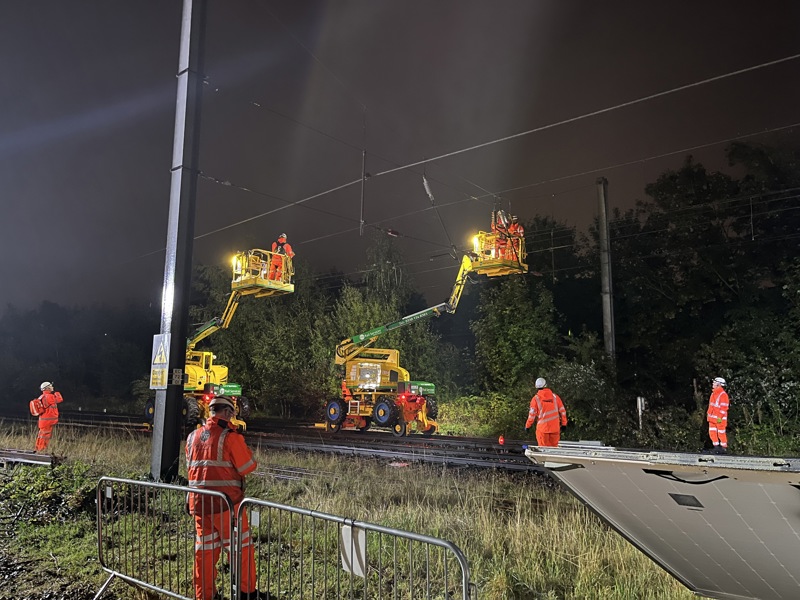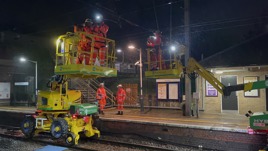Nick Brodrick stays up with Network Rail’s 'night owls' to witness the industry’s first ever zero emissions site.
Royston is asleep. It’s been several hours since the day’s final Thameslink service from London deposited some of its passengers, en route to Cambridge (“where this train terminates”).
But even in the small hours, life on the railway in this pocket of Hertfordshire doesn’t stop.
For Network Rail’s infrastructure engineers, the day is just beginning. It’s a fact of railway life that the routine renewal of 45-year-old overhead catenary equipment (in this such case) can only take place during an out-of-hours possession. That invariably means in the hours of darkness.
But what makes this night shift especially different is that it is being played out in quietness. Anyone who has been close to ‘planned engineering work’ will know that its associated noises can make for a sleepless night. Yet four nights of overhead line equipment (OLE) work are being tackled with little more than the dull sound of steel wheels rolling on rail and the murmur of around two dozen NR personnel.
There are several Mobile Elevated Platforms (MEWPS) scuttling around, and generators to charge lights and mess facilities. And yet… almost silence. At times, the most you can hear is the persistent patter of rain on Royston’s asphalt- smothered platforms, instead of the customary growl of diesel engines.
But silent nights are not the driving factor for this activity. Rather, it is fuelled by Network Rail’s bold ambition to achieve net zero carbon emissions by the middle of the century.
Working under a possession, four new yellow-clad Promax-engineered MEWPS (supplied by Pro Rail Services of Welwyn Garden City) are driven in parallel through Royston’s Up and Down platforms, pausing momentarily at each catenary mast where engineers in hard hats renew insulators from these mobile cherry-pickers.

Although the possession was deemed a success, the weather posed an unforeseen challenge when it rained - read more in Rail 1003, on-sale February 21.
The ‘RR14 EVO-2-400’ classified machines feature Bosch ‘clean-burning’ diesel engines, which proudly outperform ‘Tier 4’ emissions standards in ‘normal’ power mode.
But of greater significance is their ability to be driven purely by interchangeable 400 Ah lithium batteries, each of which last for up to eight hours (and charged during non-work hours).
By making use of an on-site 80kWh battery pack, itself charged off-site by solar power, NR’s ‘Orange Army’ completed the four-night project without producing any carbon emissions.
Other key aspects of the work site are also powered by the 80kWh battery pack, namely welfare facilities (provided by Vanguard Services Ltd) and an electronic vehicle (EV) charging point for workers’ cars.
Portable LED lighting for the work compound was provided by small solar panels and miniature wind turbines. And on a smaller yet symbolic scale, only battery-powered tools were used, as well as exclusively recyclable plastic and paper consumables.
The combination of these green credentials makes Royston a zero-emission first for any NR engineering project.
RAIL’s invitation to see the ‘renewable rail renewal’ scheme in Royston represented a landmark for NR’s London North Eastern & East Midlands Route Director, Paul Rutter.
















Login to comment
Comments
No comments have been made yet.